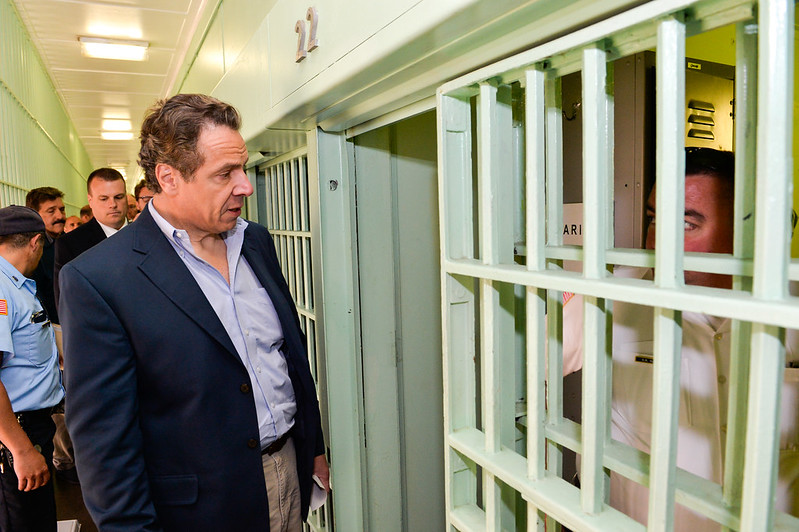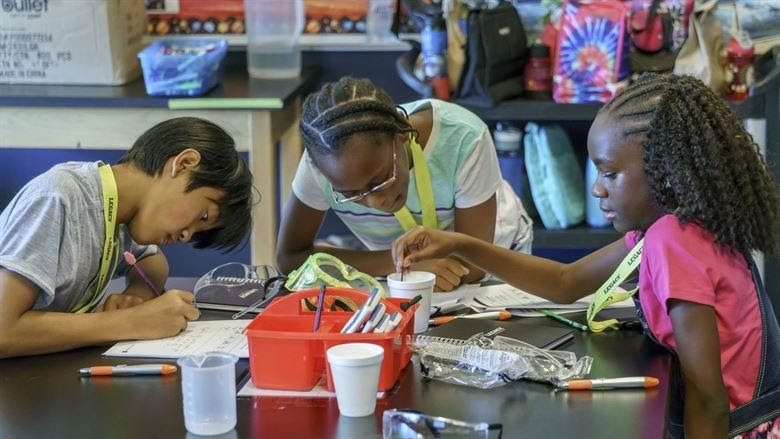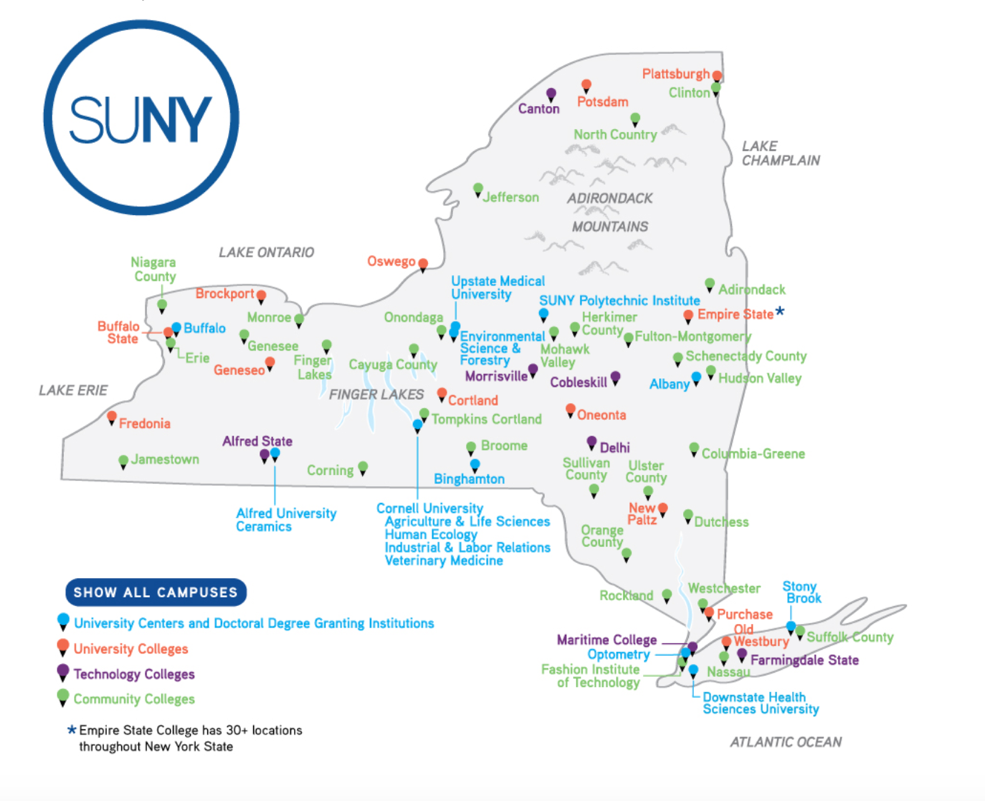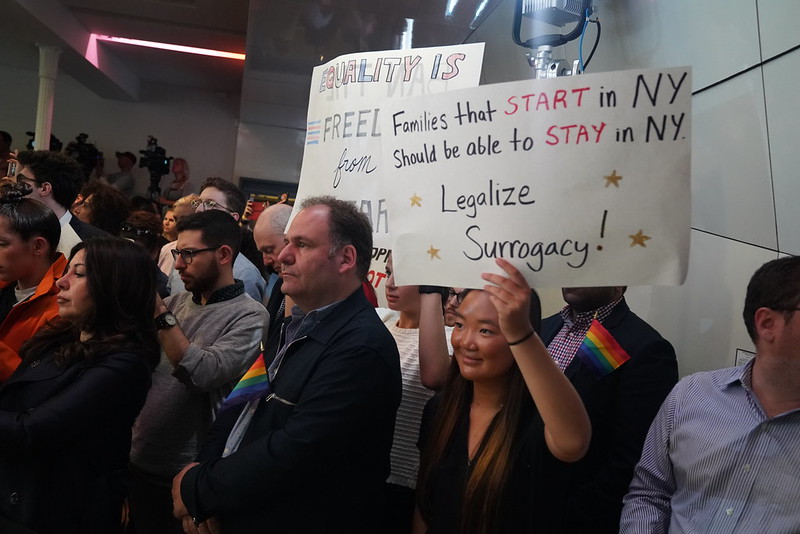Where Governor Cuomo is Turning a Blind Eye to Coronavirus Spread and Must Take Life-Saving Action Now

Gov. Cuomo tours a prison (photo: Governor's Office)
At the time of this writing, more than 287 detainees in New York City jails and 441 Department of Correction staff members have tested positive for the new coronavirus, COVID-19. Each of these men and women have friends and family members who wake up every morning, desperately hoping not to receive that dreaded call they know is increasingly possible. And there are thousands more families with loved ones in state prisons who carry that same fear.
The news gets more dire each day. This past week, Michael Tyson, a 53-year-old man, became the first incarcerated person at Rikers Island to die from COVID-19. Just a few days before that, Juan Mosquero died in the infirmary at Sing Sing Correctional Facility—the prison up the river in Ossining. They’re the first tragic coronavirus-related deaths in our state’s jails and prisons, but the data tells us that they won’t be the last.
We know the perilous situation facing thousands of New Yorkers. As two formerly incarcerated individuals, this is personal.
Make no mistake: the standard condition inside correctional facilities is never conducive to health and wellbeing. Prisons and jails are unhealthy environments for all people—whether they work on staff or live there—and amidst a viral pandemic, correctional facilities represent a humanitarian crisis. You can’t perform proper “social distancing” and pandemic personal care in these facilities, where soap and cleaning supplies are rationed, and sanitizer and alcohol products are contraband.
When we were in prison, it was not uncommon to have three or four people held in a small cell, which often included toilet facilities. Meals and recreation were available only in crowded groups.
Which is why, in light of the current situation, it is critically urgent that Governor Cuomo release a comprehensive plan for humanely and properly reducing prison populations across New York. Because while he has taken some key initial steps, he has resisted calls to comprehensively address the looming full-blown crisis in New York’s jails and prisons.
While lowering the populations of New York’s expansive system of locally-operated jails requires buy-in from local governments across the state, the Governor has the sole authority to drastically reduce the state’s prison population today. The Governor could release elderly people, those with chronic conditions, and women who are pregnant and have immune deficiencies. He could introduce a moratorium on incarceration for technical violations of parole and grant early parole to people who are within 180 days of completing their sentences.
These aren’t radical steps. They’re sensible ones. They should have been taken weeks ago; they should be done today.
Other states, including more conservative ones like Ohio and Kentucky, under Republican and Democratic chief executives alike, are taking significant actions to reduce their prison populations. Governors in our neighboring states of New Jersey and Pennsylvania have swiftly implemented solutions to address mass incarceration by removing elderly and ill detainees and those who pose no threat to public safety from facilities into expanded home detention in response to the virus. And for good reason: across America, older adults make up a larger share of state prisons than people 18-24, and there are 150,000 incarcerated people above 55 years old. In San Francisco, the jail population has gone from 1,238 to 766 since the crisis began, and crime rates have plunged.
Astonishingly, Governor Cuomo said more than a week ago that he has no plans to reduce the prison population, almost trying to say it wasn’t possible, even as he sounds repeated alarms for New Yorkers to keep their distance from each other and while a stack of clemency applications for qualified individuals sits on his desk. The Governor can, with the stroke of a pen, choose to release anyone in state custody. He can choose the safety and wellbeing of people in prisons, including corrections officers, and people in the larger community by flattening the curve behind the wall. He can act.
In this global health crisis, we must not condemn people in prison to death through inaction. Hundreds of public health officials and judges have signed letters urging for immediate releases to stem the shocking rise in infections in jails and prisons. We proudly join them to demand that our families, friends, and community members be released, and we stand ready to support people with community services once they are home.
There is still time for Governor Cuomo to flatten the curve behind the wall. As the coronavirus spreads, we can no longer keep it out of our correctional facilities, but we can still take immediate steps to prevent the deaths of thousands of people detained in our jails and prisons, as well as thousands who go to work in them and their family members. And we have the opportunity to emerge from this crisis a more equitable and safe New York.
***
Khalil A. Cumberbatch and Topeka K. Sam are formerly incarcerated New Yorkers who lead New Yorkers United for Justice. On Twitter @KhaCumberbatch & @TopekaKSam & @NYforJustice.
***
Have an op-ed idea or submission for Gotham Gazette? Email This email address is being protected from spambots. You need JavaScript enabled to view it.
Upstate Summer Camps for City Kids: Start Planning Now

Students enjoying enrichment activities at a Fresh Air Fund Camp (photo: Fresh Air Fund)
The crisis in New York City apartments and neighborhoods grows by the day. Social distance saves lives, but the effects of long-term isolation on families and children will be felt for years unless creative action is taken now.
New York State needs to plan and develop a system of large sleep-away summer camps upstate for city kids who are otherwise facing many months of life in overcrowded apartments. As the temperature rises, and school reopening is delayed, so will family frustration. Shuttered playgrounds and Mayor de Blasio’s massive cuts to the summer youth employment program will only worsen the situation come the summer months.
Where could such extensive summer camps be developed? The upstate campuses of State University of New York (SUNY) and private colleges that have shifted to online learning through the summer can be rapidly developed into such camps. The closure of colleges has left empty dorms (with space for many thousands of kids), classrooms, cafeterias, gyms, and quadrangles that could be refashioned in the coming weeks, for a June 1 start date, as enrichment camps for K-12 students.
Such a plan for campuses, of course, assumes that they will not be needed for medical use thanks to social distancing. So far, thankfully, Governor Cuomo’s successful PAUSE program has forestalled the transformation of campuses into hospitals. We should, therefore, find creative uses for such amazing facilities in a time of social crisis. If the Javits Center can become a hospital, then college campuses can become summer camps.
 (The scale of the SUNY system, and the large number of residential dorms, offers opportunities for extensive summer camp programs. Private campuses could also be utilized.)
(The scale of the SUNY system, and the large number of residential dorms, offers opportunities for extensive summer camp programs. Private campuses could also be utilized.)
Why send the students to camp? All kids need regular sociability with children their own age for mental health; X-Box, group chats, and Netflix are not going to sustain healthy child development. Campuses also have lots of fields, athletic facilities, and natural surroundings that can inspire students and help them stay fit. Campuses also have plentiful opportunities for educational enrichment. The remarkable facilities on many campuses, such as museums, instructional science labs, computer labs, libraries, and more could help make learning fun for many students. The success of the Fresh Air Fund camps can be a model for program quality.
Who would attend summer camps? Participation in the program, to be sponsored by New York State, would be free and based on voluntary parental permission. Many parents will eagerly embrace such a summer opportunity for their children. In particular, city parents with essential and dangerous jobs desperately need quality child care so that they can continue to run the trains, hospitals, sanitation, and other services the city needs.
Why sleep-away? Students who attend programs in the city and live at home can bring disease back to their apartments and vulnerable older relatives. This is one reason the mayor has cut funding for youth summer employment. At summer camp, however, asymptomatic children would not pose a risk to their parents or grandparents, especially those living in close quarters. Sleep-away camp is a way to practice social distancing while children get enrichment. Time away from families may also help reduce stress in households.
Who would staff the schools? Camp counselors will be college-age students or recent graduates. This demographic has a low viral risk factor and could work and live with children safely. Upstate counties can benefit when their young local residents get jobs in the summer as camp counselors, food service workers, nurses, custodial staff, and program administrators. Community non-profits, with extensive experience in youth programming, could run the camps. Specialty summer camps in arts or sports currently offered on upstate campuses could also be subsidized to scale up for city kids. The key to making this work is social distance. Staff and teachers must be required to live on campus away from their families and nearby towns to minimize the risk of disease.
Given the massive unemployment numbers, such an opportunity is likely to attract well-educated counselors and talented program administrators. It goes without saying that all employees in such a program, as with any youth program, must be carefully vetted. Think of this as an updated version of the successful Civilian Conservation Corp that rebuilt our parks during the Great Depression while reducing unemployment among the young.
What about the threat of disease to upstate communities, teachers, and individuals? These threats could be limited through restrictions of the children and young staff to the campuses. At traditional sleep-away camps everyone lives on campus, including the nurse, and it works. SUNY campuses are ideal because so many are on large and isolated forest and field parcels. Other private campuses are often isolated as well from the main residential areas of town or are located in areas that are primarily rural.
We all hope that a rapid medical solution to the new coronavirus can be found, but there are medium-term steps that can be taken to improve children’s physical and mental health, provide them enrichment, relieve families, and offer other benefits. New York State has invested billions in developing a magnificent system of university campuses. We should be looking at creative options for making best use of these resources during the crisis. The planning needs to start now.
***
Nicholas Dagen Bloom is Professor of Urban Policy and Planning at Hunter College and author of How States Shaped Postwar America: State Government and Urban Policy (Chicago, 2019) among other works.
***
Have an op-ed idea or submission for Gotham Gazette? Email This email address is being protected from spambots. You need JavaScript enabled to view it.
Legalization of Paid Surrogacy Will Benefit Many in New York

The push to legalize surrogacy in New York was successful this year (photo: governor's office)
The New York Legislature passed its own economic stimulus package when it legalized paid gestational surrogacy in the new state budget. Beginning February 2021, legal professionals will have a new income source by helping couples participate in paid gestational surrogacy. In addition, New Yorkers who qualify as surrogates will be able to receive compensation for carrying a child; in California, qualified surrogates with a successful history of taking a child to term can earn $80,000.
New York went from criminalizing paid gestational surrogacy to enacting the most progressive and comprehensive surrogacy law in the United States. New York is now the only state in the country to have a Surrogate’s Bill of Rights. These are statutory benefits to surrogates that must be provided by the intended parents. For instance, the intended parents are responsible for the cost of the surrogate having her own attorney. The intended parents will be financially responsible for the surrogate’s health insurance premiums during the pregnancy. The surrogate’s health insurance must extend 12 weeks after birth; if there were complications during the pregnancy, the extension of health insurance may be up to 18 weeks. The surrogate would also receive a life insurance policy during the pregnancy paid for by the intended parents and the beneficiary is designated by the surrogate.
By criminalizing paid gestational surrogacy previously, New York made the choice for all women in the state that they could not participate in this type of surrogacy. However, the legalization of paid gestational surrogacy returned to women in New York the right to make choices regarding their own bodies. As part of the Surrogate’s Bill of Rights, the surrogate maintains control of her own health and body: the surrogate can limit the number of embryos transferred into her body; the surrogate selects her own doctor; and, the surrogate is not required to agree to a cesarean section. Most importantly, the surrogate can terminate the pregnancy at any time and for any reason.
The financial implications for women who qualify as a surrogate are monumental. In speaking to a legislative aide to an Assembly member, the aide did not believe that legalizing paid gestational surrogacy would be of interest to his boss’ constituents. In the aide’s mind, such a law was really targeted to help couples who could not procreate on their own but who had the financial means to proceed with paid gestational surrogacy. However, paid gestational surrogacy in New York now permits a surrogate to be paid legally for her services. Thus, a healthy woman with limited financial means who meets the health requirements set forth in the statute now has the ability to change her and her family’s financial circumstances. Paid gestational surrogacy can help a woman help herself and her family out of a bad financial predicament and into a better one. This law is a game-changer for many women in New York.
The legalization of paid gestational surrogacy has provided couples with critical rights as well. Most importantly, upon the birth of the child, the intended parents are immediately recognized as the child’s legal parents. This is critical to same-sex couples utilizing paid gestational surrogacy. The new law further provides that a judgment of parentage may even be issued prior to birth of the child (but only become operative upon the child’s birth). The intended parents become immediately financially responsible for the child. Importantly, the surrogate would have no legal rights to the child. Defining the parties’ roles following the birth of the child is important – especially if emergency medical decisions need to be made regarding the child.
Those who opposed legalization of paid gestational surrogacy claimed surrogates became “Handmaids,” surrogacy enslaved women, and that surrogacy dehumanized women. However, women have not suffered such fates in the 47 other states where paid gestational surrogacy has been legal. Women in New York will now be fortunate to provide a child to parents who cannot bear their own. It is hard to argue with a law that brings the gift of life.
***
Eric Wrubel, Esq., is Chair of the Matrimonial Department of Warshaw Burstein, LLP.
***
Have an op-ed idea or submission for Gotham Gazette? Email This email address is being protected from spambots. You need JavaScript enabled to view it.




